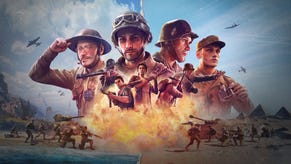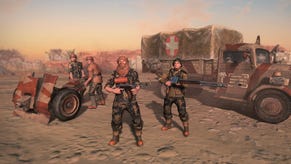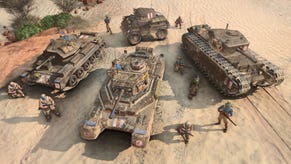Company of Heroes: a brilliant PC game lacking in technical ambition
Plus: those all-important optimised settings.
If I had to sum up Company of Heroes 3 in a single sentence, I would say it is an excellent real-time strategy game that is technically sound - but also unambitious. I'm enjoying the game but I don't feel it's pushing boundaries in the way that its predecessors did. So, on the one hand, it does feel like a missed opportunity to a certain extent but the flip side is that it's very easy to run on very high settings across a range of hardware.
I was really eager to cover this one because it's an RTS with a very different spin, putting you in command of an allied or axis force from a top-down perspective. The goal of the game is not just to overcome the enemy while micromanaging your base and resource gathering. The point is to capture and hold territory, which then furnishes you with resources to equip and expand your small force. There are no vast armies here, just a company of troops, where infantry are moved and requisitioned as a squad. There's no Starcraft-style building queue and you aren't churning out units in their hundreds to send to their deaths like Command and Conquer.
Company of Heroes is all about keeping each individual unit alive for as long as possible, adhering to cover, utilising special abilities and gaining further experience that translates into new advantages on the battlefield. New troops are not as effective as experienced veterans, so the winning commander typically has good micro-management and positioning skills. In short, this is a different form of RTS with a smaller, more tactical nature. That's what made 2006's Company of Heroes so compelling and it's in revisiting the original release and the 2013 sequel that I began to realise how technologically unambitious the new game is by comparison.
Let's be clear - the game still looks great and has a lot going for it. Geometric detail is higher, to the point where zooming in on a fruit cart in the battlefield shows each individual fruit. Similarly, Company of Heroes 3 sees a unified push to make all textures and materials authored in a physically-based manner: the metals of tanks have a really great look to them and look very different from the stone or dirt around them in terms of material quality. Textures are also generally authored at a higher resolution than ever before, and importantly, without a lot of the detail pre-painted in the diffuse texture, so they do not look overly noisy. The detail is now driven by material properties, like a modern game.
Animations are also of a high quality - zoom in on some infantry in combat and you can see them working the action of their weapons, showing obvious recoil on firing - and there are also bespoke animations per unit when reloading occurs as magazines are switched out. When combined with the granular destruction that the series is known for, where buildings explode and where every piece of cover you see can be destroyed or flattened by vehicle, then yes, Company of Heroes 3 looks quite beautiful. However, there's plenty that could benefit from further improvement.
One of the best examples can be found with the game's shadows: the game uses shadow maps and the transition between different quality levels is jarring at close range. The older Company of Heroes titles did this better - even the first game from 2006. The new sequel is more highly detailed, but with its odd shadows, it looks oddly sterile in comparison. The new details to geometry and textures are not so noticeable because they are not shadowed correctly.
| 60Hz Optimised Settings | 120Hz VRR Optimised Settings | |
|---|---|---|
| Image Quality | Maximum | High |
| Physics Quality | High | High |
| Shadow Quality | High | Medium |
| Texture Quality | Ultra | Ultra |
| Geometry Quality | Maximum | Maximum |
| Anti-Aliasing | High | Low |
| Resolution Scale | 100% | 83% (If Needed) |
Another indication of a more conservative approach to innovation is the novel use of the latest cutting-edge technology. The original Company of Heroes was one of the first DX10 games, using the new API to improve shadow and lighting quality while punishing GPUs at launch with the highest settings. Company of Heroes 2 was infamous in 2013 as its DX11-powered graphics were similarly heavy when set to their highest. This kind of graphical newness is missing in Company of Heroes 3. Even though the new game has transitioned to a new DX12 version of the 'Essence Engine', there's no real indication that the new API is being pushed hard in any obvious way. For example, ray tracing is nowhere to be found, and something like ray-traced shadows would have been a computationally cheap and amazing way to solve the visual issues with shadows in this game.
In fact, Company of Heroes 3 is really light on the GPU. Booting the game on my Core i9 12900K system paired with an RTX 4090, the maxed out experience hit 200fps at 4K resolution. That's great for those who like high frame-rates, but for maximum settings it's a bit of a let-down. Unlike its predecessors, there's nothing new here to push the latest PC hardware and I think that translates into untapped potential to make the game look better.
Optimised settings? There's an argument that you don't really need them as the options concentrate mostly on graphical effects when the primary bottleneck is often on the CPU side. It's easily possible to be CPU-bound in Company of Heroes 3, even at 4K resolution. When you look at that CPU utilisation, the game is using a lot of cores and threads with all the other AI players, but you can still see that there is a single-threaded limit to the load. It's not really the behaviour I like to see in an era where CPUs are becoming wider at a more rapid pace than single-thread performance.

.png?width=690&quality=75&format=jpg&auto=webp)
Even so, it's still possible to get high performance levels from mainstream kit, which is a good thing, or else you can target high frame-rates instead, to get the best from a high refresh rate monitor. On this page, you'll see my suggestions for various frame-rate targets, using a mainstream Ryzen 5 3600 paired with an RTX 2060 Super asiming for a 1440p output. Frame-rate not high enough to sit comfortably within the VRR window of a high refresh rate screen? A quick reduction to the resolution scale helps immensely.
In summary, Company of Heroes 3 is great fun and polished in many ways, but also 'safe' from a technical perspective. It's also relatively light on shader compilation #StutterStruggle, with only a handful of hitches in the initial 30 seconds of the tutorial mission, with the rest of the game playing out as smoothly as can be.
The game runs really well even at max settings, but there's still the sense that the developer should have pushed further on the GPU side: RT shadows and ambient occlusion would have made a big difference to the presentation. In short, I wasn't disappointed by the game - and I'm sure the light GPU requirements will ensure that more players get a smooth experience - but where prior series entries pushed new boundaries within the genre, Company of Heroes 3 does not.














.png?width=291&height=164&fit=crop&quality=80&format=jpg&auto=webp)

